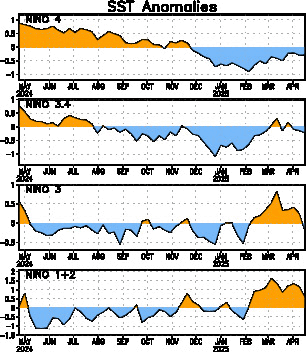Is getting cold very fast in the ENSO areas.
http://www.cpc.ncep.noaa.gov/products/a ... odisc.html
Synopsis: Conditions are favorable for a transition to La Niña conditions during June – August 2010.
El Niño dissipated during May 2010 as positive surface temperature (SST) anomalies decreased rapidly across the equatorial Pacific Ocean and negative SST anomalies emerged across the eastern half of the Pacific (Fig. 1). All of the Niño indices decreased between 0.5oC to 1.0oC during the month (Fig. 2). Since the end of February, subsurface heat content anomalies (average temperatures in the upper 300m of the ocean, Fig. 3) have decreased steadily. Below-average temperatures have strengthened at depth and currently extend to the surface in parts of the eastern Pacific (Fig. 4). Also during May, enhanced convection persisted over Indonesia, while the area of suppressed convection strengthened and expanded over the tropical central Pacific (Fig. 5). The low-level easterly trade winds strengthened over the western and central equatorial Pacific, and anomalous upper-level westerly winds prevailed over the east-central Pacific. Collectively, these oceanic and atmospheric anomalies reflect the demise of El Niño and return of ENSO-neutral conditions.
The majority of models predict ENSO-neutral conditions (between -0.5oC to +0.5oC in the Niño-3.4 region) through early 2011 (Fig. 6). However, over the last several months, a growing number of models, including the NCEP Climate Forecast System (CFS), indicate the onset of La Niña conditions during June-August 2010. There is an increasing confidence in these colder model forecasts, which is supported by recent observations that show cooling trends in the Pacific Ocean and signs of coupling with the atmospheric circulation. Therefore, conditions are favorable for a transition to La Niña conditions during June-August 2010


















